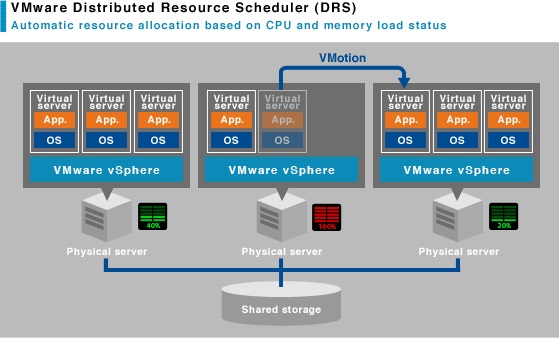What is VMware DRS?
VMware Distributed Resource Scheduler (DRS) enables organizations to optimize the allocation of computing resources across their virtualized environments. DRS works by continuously monitoring the resource utilization of virtual machines and automatically moving them between hosts in a cluster to ensure optimal performance and resource utilization.
At its core, VMware DRS uses a set of algorithms to analyze the workload of each VM in a cluster and determine the best host for it to run on. This analysis takes into account factors such as CPU and memory utilization, network bandwidth, and storage I/O. Based on this analysis, DRS can then migrate virtual machines between hosts in the cluster to balance the workload and ensure that each has access to the resources it needs.
A balanced cluster is one in which the hosts are evenly distributed between virtual machines regarding resource consumption. When a new VM is added to the cluster, it is automatically allocated the most optimal host based on its resource consumption requirements. However, virtual machine workloads sometimes change, causing imbalances in resource distribution.

The role of DRS is to detect this imbalance and either recommend that the VMs causing the imbalance be migrated to less busy hosts, or to perform this migration automatically.
DRS Automation Levels
The DRS automation level can be set to manual, partly automatic or fully automatic. What is the difference?
-
Manual – vCenter only recommends moving resources.
-
Partially automated – after creating a VM and enabling it, vCenter automatically allocates the VM to a more appropriate host to keep the cluster balanced. Once the VM is enabled, vCenter will provide migration recommendations based on CPU and memory usage. The vSphere administrator must approve the migration.
-
Fully automated – vCenter controls the initial allocation and migration of virtual machines. Everything is fully automatic, and the administrator receives no messages regarding the recommendations. No decision from the administrator is needed to keep the cluster balanced.
VMware DRS features/benefits
Optimization of infrastructure without manual intervention by continuously monitoring resource utilization and making automatic changes. It helps organizations optimize their infrastructure without manual intervention. This saves time and reduce the risk of human error, while also ensuring that virtual machines are always running on the most appropriate host.
Flexibility. Distributed Resource Scheduler can be configured to operate in either manual or automatic mode, allowing organizations to choose the level of control they want over resource allocation. It also includes features like affinity rules and anti-affinity rules, which allow administrators to specify which virtual machines should or should not run on specific hosts in a cluster.
VMware DRS includes predictive DRS, which uses historical performance data to predict future resource requirements and proactively move virtual machines to the most appropriate host. This can help organizations avoid performance issues before they occur and ensure that virtual machines always have access to the resources they need.
Integration with other VMware technologies like vMotion and Storage vMotion. This enables live migration of virtual machines between hosts and data stores, making it easy to move VMs around the infrastructure to optimize performance and resource utilization.
Enterprise-class reliability and availability. VMware DRS includes features like admission control, which prevents overprovisioning of resources and ensures that virtual machines always have access to the resources they need. It also includes integration with VMware High Availability (HA), which can automatically restart virtual machines on another host in the event of a host failure.




